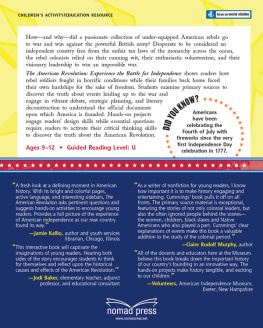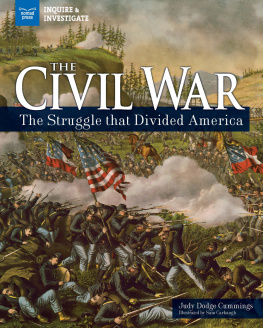
Nomad Press
A division of Nomad Communications
10 9 8 7 6 5 4 3 2 1
Copyright 2017 by Nomad Press. All rights reserved.
No part of this book may be reproduced in any form without permission in writing from the publisher, except by a reviewer who may quote brief passages in a review or for limited educational use. The trademark Nomad Press and the Nomad Press logo are trademarks of Nomad Communications, Inc.
ISBN Softcover: 978-1-61930-616-5
ISBN Hardcover: 978-1-61930-612-7
Educational Consultant, Marla Conn
Questions regarding the ordering of this book should be addressed to
Nomad Press
2456 Christian St.
White River Junction, VT 05001
www.nomadpress.net
Titles in the
Mystery & Mayhem Series






Check out more titles at www.nomadpress.net
Introduction
Run for Your Life
The door to freedom slams shut and the lock snaps into place. Darkness surrounds you. First, the gloom clouds your vision, then it seeps into your soul. Your heartbeat quickens. Suddenly, you cannot seem to draw enough air into your lungs. You are trapped. Will this prison become your tomb?
But hope is not lost. The glimmer of an escape plan forms in your brain. It will be dangerous, even foolhardy. You have to muster every last ounce of courage and strength. Do you have what it takes to run for your life?
The human spirit craves freedom. When liberty is lost, people go to great lengths to get it back.
In this book, you will read about five ingenious escapes. Youll meet people willing to do whatever it takes to flee their surroundings.
Prisons take many forms. For example, slavery once doomed African American slaves to the lifelong prison of their masters whims. But in 1848, William and Ellen Craft made a bold dash for freedom. Donning clever disguises, the married couple escaped in broad daylight and fled 1,000 miles.
In another time and place, Douglas Mawson battled a power greater than any human villain. In 1913, Mother Nature trapped him in her icy Antarctic jaws. Alone and dangling by a fraying rope over a bottomless crevasse, all Douglas had to help him escape were his strength and his will to live.
In 1943, Nazi guards packed Belgian Jews into trains headed for Auschwitz, a concentration camp where millions of people were killed. The train cars were so crowded, people had to take turns sitting down. A hunk of moldy bread and a mouthful of water was their only sustenance.
As bad as the train was, 11-year-old Simon Gronowski knew what awaited him at Auschwitz would be worse. He was determined to find a way off the train as it hurtled ever closer to its ghastly destination. How would you escape?
Alcatraz was a rocky prison fortress designed to hold inmates until the end of their sentence or death, whichever came first. Prison officials bragged that it was impossible to escape. But in 1962, three inmates vanished, never to be seen again.
A wall divided the German city of Berlin down the middle for 28 years. This concrete barrier separated families and was closely guarded by communist East German police. East German citizens were not allowed to flee to democratic West Germany. But during two days in 1964, 29 East Germans crawled under the wall in a desperate race for freedom.
These people all faced different kinds of prisons, but they shared common traits. They had guts, grit, skill, and a lot of luck. Keep reading and you may find your pulse quickening as if you, too, were running for your life.


For more than 200 years, slavery was legal in the United States. Punishments for trying to escape were severe. Runaways who were caught were whipped, maimed, or sold.
However, slavery was so awful that tens of thousands of enslaved people took their chances and ran. Most slaves fled in the middle of the night. They hid out in swamps and forests and were chased by bloodhounds. These flights for freedom usually ended in failure.
The story of William and Ellen Craft is different. This couple escaped from slavery in broad daylight and in first-class comfort.

William Craft knew sorrow. Born a slave in Macon, Georgia, in 1824, his parents and brother were sold when William was young. He was left with only his little sister. Then, when he was 16, William lost her, too. Their owner had fallen into debt and decided to sell the two children.

Illustrated London News, England, February 16, 1861
Slave auctions were often held on the steps of the courthouse. As townsfolk strolled past, buyers examined the human wares. The slaves were lined up according to height, and the slave trader ordered them to remove their coats or shawls.
Interested buyers ran their hands over the slaves bodies, fingering joints and kneading muscles. Slaves kept their faces blank while their mouths were pried open and their gums examined for signs of disease. A slave might be stripped to the waist by buyers looking for scars of whippings. No one wanted to buy a disobedient slave.
Sellers ordered the slaves to jump and dance so buyers could judge their strength and nimbleness.
William might have been spared this humiliation because he was a skilled worker. His owner had apprenticed William to a cabinetmaker, where he learned carpentry. Southern industry was expanding in the early nineteenth century and people needed laborers. Anyone who bought William could make a tidy profit by renting him out.
Williams sister was sold first. As her new owner led her away, the auctioneer ordered William to step up on the auction block. But the boy could not take his eyes off his sister. William motioned to a slave friend standing nearby.
Run and ask the man who bought my sister if he can wait until I am sold, William said, so I can bid her farewell. The friend ran after the man, but returned a moment later with bad news. The buyer refused to wait.
William turned to the auctioneer and fell to his knees. Please, sir, he begged. May I just step down a moment and bid my sister a last farewell?

























